Accessories For the FTS6000
All of these accessories can be directly installed into the sample compartment of the FTS6000 and fixed into position with a bolt. In all cases it is essential to take a background spectrum with the accessory installed before sample scans are acquired.
Pike Veemax
This is a Specular reflectance accessory and relies on the mirror-like reflection from the surface of the sample. The photograph below shows it installed in the sample compartment of the instrument.
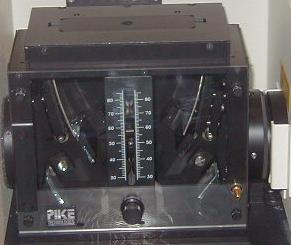
A polariser is available for use with this accessory. The accessory once installed must be connected to the sample compartment purge inlet with a flexible tube, it may then be necessary to wait for several hours until all moisture is removed from the accessory.
Gold substrates for deposition of organic films to be studied by reflection can be prepared, on silica microscope slides and other substrates, using the SAF’s evaporator.
Samples are simply placed inverted on the top of the accessory (on the mask, see below, which is most suited to their size) and the data collected. However a background spectrum is required first, unless an obvious surface (such as a bare substrate) is available a gold mirror can be used for this. The angle of incidence can be selected from 80 to 30 degrees by using the adjustment knob on the front of the accessory (generally the background should be obtained using the same mask and at the same angle of incidence as the sample spectrum).
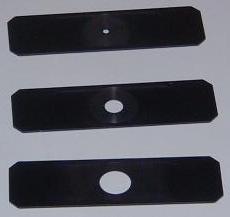
Graseby Specac Reflection Accessory
This, like the Veemax, is also a Specular reflectance accessory, the photograph below shows it installed in the sample compartment of the instrument.
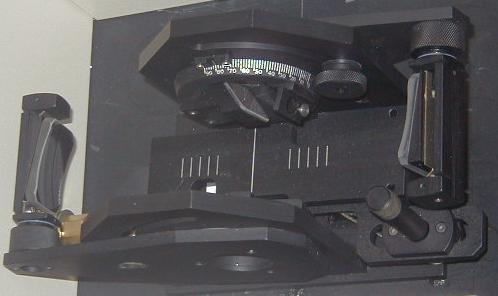
This accessory is harder to align than the Veemax as the mirrors have to be set at the required angle independently and the aligned. As with the Veemax unless an obvious surface (such as a bare substrate) is available a gold mirror can be used for this. Also for all samples the height at which they are placed must be almost exactly the same as the background sample, if it is not interference fringes will probably be observed. The main two advantages over the Veemax are that the surface of the sample to be studied faces upwards, hence reflectance spectra from the surface of liquids can be obtained (A PTFE trough platform is available for this purpose), and that larger incident angles are achievable. However despite the beam being focused onto the sample for large incident angles large samples are required, also due to the beam focusing a significant spread of incident angles is always being used to obtain the spectrum. As with the Veemax a polariser is available for use with this accessory.
Spectra-Tech Beam Condenser
This is a 4 times Beam Condenser (it reduces the beam size by a factor of 4 to about 2mm in diameter) and hence enables small samples to be studied by transmission or ATR. The photograph below shows it installed in the sample compartment of the instrument, the micro ATR liquid cell installed.
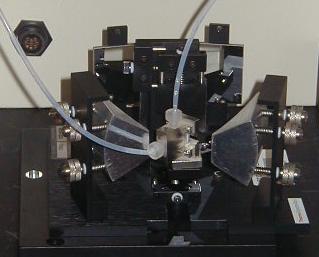
For transmission measurement a sample holder (shown below) is available, this is designed to hold pellets pressed into paper inserts and 13 mm pellets or mulls prepared on 13mm diameter discs. However with this adaptable holder it is possible to support a wide variety of different small samples.
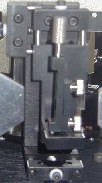
To use this for transmission measurements a background spectrum should be acquired with the condenser and sample holder in place (but without the sample mounted). Then the sample should be mounted and its spectrum obtained.
Spectra-Tech Micro ATR
This micro ATR, as purchased, enables solid samples to be pressed onto the surface of an ATR crystal (held in place by a paper insert). The crystal holder is shown in the photograph below without the pressure plates installed (these enables the necessary load/pressure to be applied to make good contact of a solid sample with the ATR crystal).
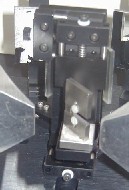
A stainless steel and Teflon liquid cell, shown in the photograph in the Beam Condenser section, has been designed and constructed for used with this accessory. It enables a liquid to be introduced onto only one face of the prism, whilst in the sample compartment of the spectrometer the other faces were open to the air, which was scrubbed to remove water, carbon dioxide and hydrocarbons. With this cell it is possible, if required, to maintain constant flow of liquid over the crystal surface. Combined electrochemistry and ATR IR spectorscopy is also available with a specifically designed ATR cell and the SAF’s potentiostat.
The background spectrum should be recorded with a clean prism in place, once this has been recorded then the sample can be introduced and its spectra recorded. For this accessory the cost of prisms (June 2002) is given below:
| Prism |
Cost |
| Ge 30 degrees |
£70 |
| Ge 45 degrees |
£60 |
| Ge 60 degrees |
£60 |
| KRS-5 45 degrees |
£75 |
| KRS-5 60 degrees |
£85 |
| Si 30 degrees |
£65 |
| Si 45 degrees |
£60 |
| Si 60 degrees |
£60 |
| ZnSe 30 degrees |
£90 |
| ZnSe 45 degrees |
£65 |
| ZnSe 60 degrees |
£65 |
for information on which ATR crystal suits your needs best click here.
Specac Benchmark ATR
The photograph below show the horizontal 6 reflection Benchmark ATR (and Si prism) installed in the sample compartment of the instrument. Sufficient sample is required to cover a crystal sampling surface area of at least 72mm long by 10mm wide.
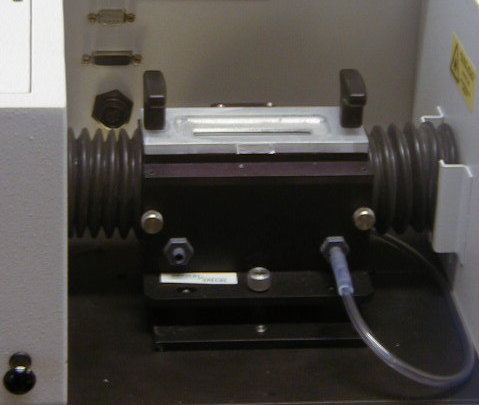
A polariser is available for use with this accessory. The accessory once installed must be connected to the sample compartment purge inlet with a flexible tube, it may then be necessary to wait for several hours until all moisture is removed from the accessory. Then the background spectrum can be recorded with a clean prism in place, once this has been recorded then the sample can be introduced and its spectra recorded. For this accessory the cost of prisms (July 2002) is given below:
| Prism |
Cost |
| Ge |
£530 |
| KRS-5 |
£500 |
| Si |
£500 |
| ZnSe |
£310 |
for information on which ATR crystal suits your needs best click here.
A clamp (shown installed below) is also available, this allows for the necessary load/pressure to be applied to make good contact of a solid sample with the ATR crystal.
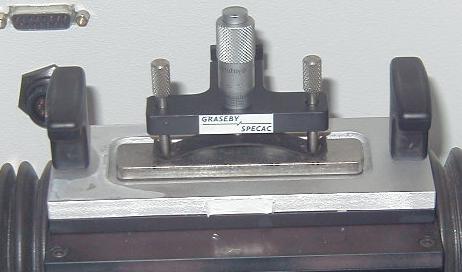
DuraSamplIR Diamond ATR
The DuraSamplIR II (shown installed in the FTS6000 sample compartment in the photograph below) is a high performance diamond (ATR) accessory. It allows you analyze a broad array of samples including abrasive powders, hard materials, challenging solids, films, pastes, gels and corrosive liquids.
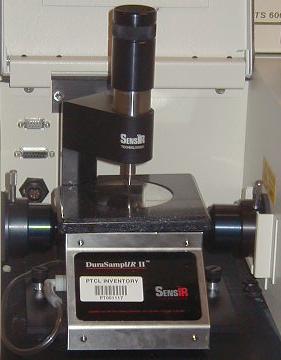
After installing the accessory and connecting the purge tube it may be necessary to wait several hours, so that all moisture is removed from the accessory. Before recording a spectrum of your sample you must first record a background spectrum of the clean diamond. Measurements are performed by placing the sample in direct contact with the diamond surface. The very small sampling surface requires only a small amount of material and assures the repeatable contact necessary for quantitative analysis. For liquids just place a few drops on the diamond, if your sample is volatile a cover is available. For solid samples a compression tip held magnetically in the press should be used. The press is torque limiting and should be tightened onto your sample until it clicks then the spectrum can be recorded. A full manual for this accessory is available here.
Variable Angle Transmission
A variable angle of incidence transmission accessory (shown in the photograph below) has been constructed it enables transmission spectra of solid samples to be collected at angles other than normal incidence. Transmission spectra of materials with polished surfaces (such as Silicon wafers) tend to contain interference fringes, this accessory with a polariser allows the spectra to be collected at Brewster’s angle and thus remove the fringes completely.
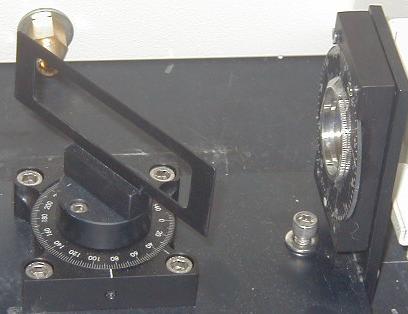
When using this accessory either use an uncoated substrate for your background or with the sample holder in place (but without the sample mounted), then put your sample in the beam and record its spectrum.
Back to the instruments page